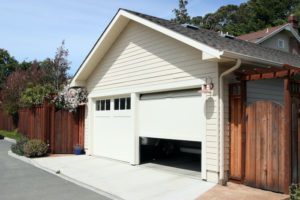
Do You Have the Signs of an Unbalanced Garage Door?
An unbalanced garage door can be a significant problem for your garage door operator. For those who regularly use the garage door, this can be an unpredictable danger that lies ahead.
If you can’t find what you’re looking for by reading our troubleshooting tips, call us, and we’ll diagnose and fix the problem. If you’re a Huntsville or North Alabama homeowner whose garage door has the symptoms of an unbalanced garage door, contact Overhead Door Company of Huntsville/North Alabama™. Our technicians know what to do to get your door back working as it should.
Garage Door Balance Disclaimer
The information provided in this blog post is for informational purposes only. Checking or adjusting a garage door’s balance involves components under extreme tension, such as springs and cables, which can be hazardous if handled improperly. Overhead Door Company of Huntsville/North Alabama™ assumes no responsibility or liability for any injuries or damages resulting from troubleshooting or repairs based on this content. For safety and proper adjustments, always contact a professional garage door technician.
What makes a garage door balanced or unbalanced?
A garage door is balanced when the weight of the door is evenly supported by the tension of the springs. When unbalanced, either the springs aren’t providing enough tension, or they’re exerting too much. This imbalance places strain on the opener and can lead to premature breakdowns of key components like drive gears, carriages, sprockets, and couplers. In severe cases, it may even result in a spring or cable snapping.
The Importance of a Properly Balanced Garage Door
Your garage door is one of your home’s heaviest and most frequently used parts, making balance critical for its safe and smooth operation. Ensuring your door is properly balanced provides several benefits.
Why Balance Matters:
- Reduces Strain on Your Opener: Garage door openers are designed to work with a balanced door. When the door is balanced, the opener only needs to lift a fraction of the door’s weight. If the door is unbalanced, the opener works harder, which can lead to motor burnout or gear wear, eventually causing costly repairs or replacements.
- Prevents Damage to Other Components: An unbalanced garage door not only affects the opener but can also damage other parts, like springs, cables, and rollers. These components are designed to work in sync, and when the door is unbalanced, they experience undue stress, which can cause fraying or breakage.
- Ensures Smooth and Quiet Operation: A balanced garage door operates quietly and smoothly, reducing noise and jerky movements. Grinding, squeaking, or banging sounds are signs of imbalance, which can cause additional strain on the opener and other components.
- Prevents the Door from Getting Stuck: A balanced door moves easily along its tracks without getting stuck. When unbalanced, the door may stall or get stuck in awkward positions. By maintaining proper balance, you can avoid these operational issues.Troubleshooting a Stuck Garage Door – Read More
- Improves Safety: Safety is a top priority. An unbalanced door can unexpectedly fall or crash down, posing a serious risk to anyone nearby. Garage doors are heavy, and accidents caused by an unbalanced door can result in injuries or property damage.
Symptoms of an Unbalanced Garage Door
If your garage door is unbalanced, there are several key symptoms to watch for:
- Takes Longer to Open or Close: The door may struggle and take longer than normal.
- Fails to Move at All: The door may refuse to budge.
- Unusual Noises: Strange sounds, such as grinding or creaking, may occur during operation.
- Uneven Appearance: The door may look slanted or uneven as it opens or closes.
- Sagging When Open: The door may droop or sag when fully open.
Additional Signs:
- Garage Door Slams Shut: The springs can’t counterbalance the door’s weight.
- The Door Doesn’t Stay Open: If your door doesn’t remain open when lifted manually, it’s likely unbalanced.
- Difficulty in Manual Operation: If it’s hard to lift manually, this suggests an imbalance.
- Garage Door Opens Too Quickly: Incorrect spring tension can cause the door to open too fast.

How to Perform a Garage Door Balance Test
It’s a good idea to perform a balance test periodically to ensure your garage door is functioning properly.
Step by Step
1. Close the Door from Inside the Garage.
2. Detach the Door from the Opener.
Pull the manual release rope to disconnect the door from the opener.
For a belt- or chain-driven opener that operates on a square rail or screw-driven opener, pull the manual release rope straight down.
For a belt- or chain-driven opener that uses a T-shaped rail, pull the manual release rope straight down and back toward the motor unit.
3. Move the Door Manually to the Open and Closed Positions.
The door should move smoothly. If it sticks or feels heavy, lubricate the rollers and hinges as indicated in your manual. If this doesn’t solve the problem, contact a professional.
4. Manually Lift the Door to the Halfway Point and Carefully Release.
The door should remain in place, supported by the springs. There may be gentle movement in one direction or the other.
If the garage door slams shut or opens forcefully, the door is out of balance.
5. If the tested door is balanced, reattach the door to the opener.
Follow the specific instructions for your type of opener to reconnect the door.
If you have a belt or chain-driven opener that operates on a square rail or screw-driven opener, pull the manual release rope down and back toward the motor unit.
If you have a belt or chain-driven opener that uses a T-shaped rail, pull the manual release rope straight down and activate the opener. Your door will reconnect automatically.
For More on How to Open a Garage Door Manually
Why Professional Adjustment Is Necessary
Adjusting a garage door’s balance involves working with springs under extreme tension. Attempting to fix these yourself can be dangerous and lead to injury. A trained professional has the tools and experience to safely adjust the tension on the springs and balance the door correctly.
Conclusion
A properly balanced garage door is critical for smooth operation, safety, and longevity. Regularly checking your garage door’s balance and addressing any issues promptly can prevent costly repairs and keep your door operating at its best.
If you suspect your garage door is unbalanced or notice any unusual behavior, don’t hesitate to contact Overhead Door Company of Huntsville/North Alabama™. Our trained technicians are ready to help ensure your garage door operates safely and efficiently, giving you peace of mind for years to come.
Need Help Balancing Your Garage Door? Contact Us Today!
A properly balanced garage door is essential to a safe and efficient system. Contact Overhead Door Company of Huntsville/North Alabama™ to schedule a balance check or any other garage door service needs. Your safety is our priority!
An unbalanced garage door usually means there is a problem with the spring. We strongly advise against trying to tackle the problem on your own. Garage door springs can be dangerous, so we recommend calling a trained and certified garage door professional.
Should You Open a Garage Door With a Broken Spring? Read More –
For more troubleshooting tips, visit our Troubleshooting Guide!
Reach Out To Us to Schedule a Service Call
Safety Precaution
Before going any further, we want to be clear. Garage doors can be dangerous, and it’s not uncommon for people to get injured while attempting any garage door repairs. Even experienced technicians with years of experience should work with caution, as it is in the highest insurance classification for a work-related injury. This is not a garage door safety guide and cannot account for every garage door situation. Always proceed with caution. When in doubt, leave the job to garage door professionals. They are familiar with the dangers of working with a garage door, hardware, and all of its moving parts.
Disclaimer: The information provided is for informational purposes only. Professionals should perform garage door repairs. Overhead Door Company of Huntsville/North Alabama™ disclaims any responsibility for injuries or damages resulting from reliance on this information.






